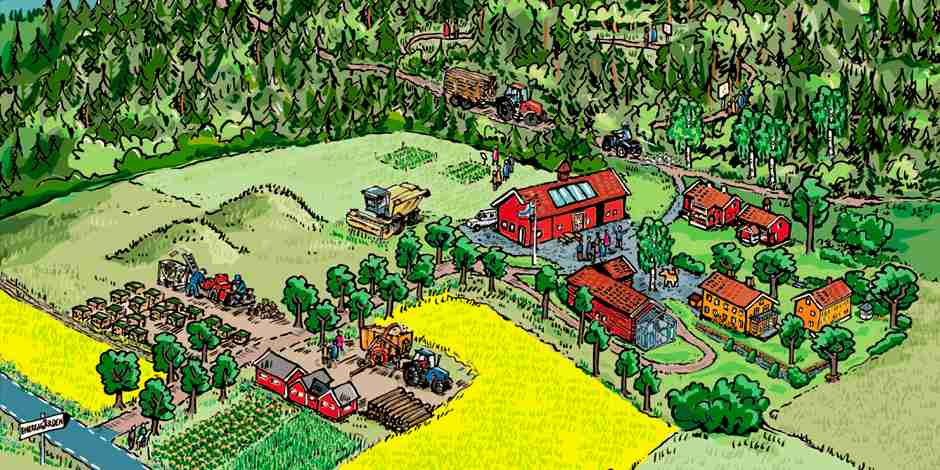The Energy Farm, Energigården, is an educational centre located in the small village of Brandbu, between Oslo and Lillehammer in southern Norway. The Energy Farm consists of newer buildings and actual farm buildings originating from the mid-1700s. Visitors can experience a number of alternatives for small- and medium-scale production and more efficient consumption of renewable energy in, on and around these buildings. Founded in 1991, over 35,000 visitors from 85 countries have been welcomed, educated and trained in decentralized and environmentally friendly energy setups.
Once bitten by the bioenergy bug
In 2013, more than 80% of the world’s consumed energy was based on fossil fuels, despite the fact that about 80% of the world’s known fossil reserves need to be kept in the ground for a fifty-fifty chance of staying below an increase by 2°C of the global average temperature. Therefore, steering away from fossil fuels and developing and investing in renewable energy is essential for the survival of humankind. Contributing to this transition, Erik Eid Hohle began to develop small-scale energy production from renewable energy on his family farm, Eidsalm. As a student in agriculture, Eid Hohle’s interest in renewable energy sparked during the oil crisis in Norway and he became a researcher. He found that many good solutions already existed but were not applied, and decided to do something about it. In 1991, he changed the name of his mother’s farm to Energigården and the farm was running on 98% renewables with 80% less greenhouse gas emissions in only a few years. Today, his son, Anders Møyner Hohle, has taken over the operation of the farm and education centre.

Sowing to harvest transition
Setting up shop in an oil-exporting country has not been an easy mission, but Eid Hohle’s conviction of the essentiality of transitioning to renewable and bioenergy has kept him going. The farm concept has now gone international. Rajendra Pachauri, president of IPCC, found the farm concept to be highly interesting. Pachauri is also leading the Indian–British research and development foundation The Energy and Resources Institute (TERI) and in August 2014, TERI and Energigården set up The Energy Farm International Foundation (EFIF). EFIF will work to establish a global network of competence and education centres for renewable energy, local decentralised energy production and energy efficiency using Energigården as a model. The first centre has already been established on a farm in Kenya, followed by projects in Ukraine, India, Myanmar and Croatia. Examples of solutions being displayed and developed at these centres are: a cooling system fuelled by cow dung; a heating system running on cooking oil; and solar-powered fans for drying grains after harvest. Assisting in mitigating deforestation, climate change and poverty is a strong motivator for Eid Hohle, and his aim is to establish at least 50 energy farms worldwide within a few years.
Connected challenges
Objectors to bioenergy say that it is wrong to use farmland for energy crops that could otherwise be used to produce food in a starving world. To this, Eid Hohle says in an interview in Aftenposten, that only 1–2% of the world’s farmland is used to produce bioenergy today, while some 25% is used to produce non-essential foods, such as tea, coffee, wine and narcotics. In addition, an excessive portion of all food produced is lost along the value chain and as food waste from households. Meat production is also in conflict, where crops that could be consumed directly by humans are instead fed to animals. Of course, food and water security is of highest importance to a growing global population on a finite planet – and so is climate change and moving away from fossil fuels. Therefore, developing and implementing small-scale, decentralised energy-producing systems that support the building of local resilience is important in both Norway and the rest of the world.
Regional dimension
Despite its small size, Energigården can play a large role in regional development of energy resilience and climate mitigation and adaptation. For example, Energigården was part of the EU project BTN (The Bioenergy Technology Transfer Network) in 2000–2006, which was established to develop and highlight good examples of sustainable use of bioenergy to help prepare regional bioenergy strategies and spatial planning processes. Energigården became a national bioenergy demonstration centre, and the EU project led to a three-year project called Bioreg Hadeland, which aimed to turn the Hadeland region into an outstanding national bioenergy region with a focus on bioenergy in practice.
Learn more…